Šakiai
| Šakiai | ||
|---|---|---|
| Town | ||
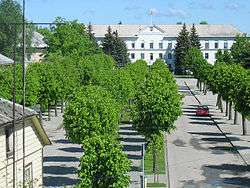 Aerial Šakiai view, featuring the Town hall of Šakiai | ||
| ||
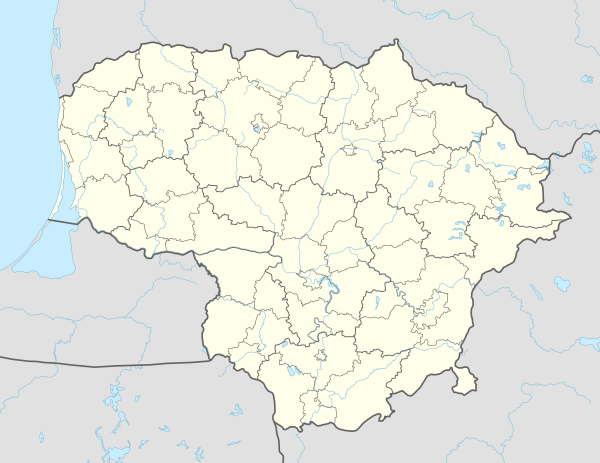 Šakiai Location of Šakiai | ||
| Coordinates: 54°57′N 23°3′E / 54.950°N 23.050°ECoordinates: 54°57′N 23°3′E / 54.950°N 23.050°E | ||
| Country |
| |
| Ethnographic region | Suvalkija | |
| County |
| |
| Municipality | Šakiai district municipality | |
| Eldership | Šakiai eldership | |
| Capital of |
Šakiai district municipality Šakiai eldership | |
| First mentioned | 1599 | |
| Granted city rights | 1776 | |
| Government | ||
| • Mayor | Edgaras Pilypaitis (TS-LKD) | |
| • Mayor deputy | Bernardinas Petras Vainius | |
| Population (2018) | ||
| • Total | 5,153 | |
| Time zone | UTC+2 (EET) | |
| • Summer (DST) | UTC+3 (EEST) | |
| Website | https://www.visitsakiai.lt | |
Šakiai (![]()
The area along the Nemunas River has been inhabited from the very oldest of times, as far back as the Stone Age, but in the district of Sakiai the traces of life left behind by the people of that period y seen from the banks of another river, the Šešupe. In the villages of Gluobiai, Kubiléliai and Ziürai, the locations of these settlements were thoroughly researched in the last two decades of the 20th century, and today those finds provide the basis for our knowledge of the inhabitants of the northwestern part of the area across the Nemunas in the Stone and Bronze ages.
A very important group of archaeological objects are the old burial grounds (necropoles). The area long the Nemunas River was settled by Highlands tribes, which from the middle of the first millen- nium until the founding of the Lithuanian state buried their cremated dead together with uncremated ss- horses. The latter were accompanied to the other world by elaborate bridles, bits with bone cro pieces, silver-plated stirrups, and bells. In a burial ground (necropolis) in the village of Pakalniškiai, the graves of 262 horses have been discovered. Next to them, a location for cremating the dead was found and researched, and unique items were found in the graves.
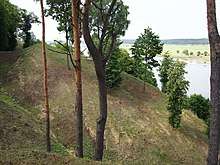
The hill-forts are a distinctive feature of archaeological heritage. 17 have been located in the district of Šakiai. At least a few of them are unique. The first of these is the complex of Sudargas hill-forts, con- sisting of two pairs of hill-forts located in the villages of Grinaičiai and Burgaičiai, which have recently been prepared to receive visitors. One of the hill-forts, the Burgaičių Vorpilis, was quite thoroughly lored in 2006-2008 by means of partial reconstruction, uncovering its defensive fortifications. An other hill-fort (Maštaičiai-Narkünai) bears witness to the Lithuanian struggles against the Teutonic Order, as it was the location of the Teutonic Order's Bajerburg castle (1344-1384).
The most significant state-protected complexes of church structures include the Church of the Transfiguration of Christ at Griškabüdis, the Church of the Exaltation of the Holy Cross and the manor t Iguva, the Church of Saint Michael the Archangel at Kaimelis, and the Church of Saint Vincent de Paul at žemoji Panemuné, as well as the Church of the Finding and Exaltation of the Holy at Kudirkos Naumiestis and the Church of the Most Blessed Virgin Mary, Liberator of Prisoners t Sutkai. Nevertheless, the majority of churches in the Sakiai area are valuable not only in terms of their historical and architectural significance, but also because of the works of art preserved in them. A particularly special treasure is the bell of the church at Plokščiai, which was cast in the second half o the 16th century. Several 17th century objects of exceptional value are also preserved at the church.
History
The largest and most varied part of the sacral art heritage consists of works dating from the middle of the 18th to the beginning of the 20th century. The churches of Griškabüdis and Kudirkos Naumiestis are distinctive for the value of their altars, other installations, and furniture ensembles, their paintings of a high artistic level, their sculptures, their examples of applied art, and just the sheer number of all the works. Both churches were built by Carmelit es of the Ancient Observance and both have preserved a part of their artistic heritage. Valuable examples of religious folk painting and wood Il as an impressive altar dating from the beginning of the 20th century have survived in modest Gražiškiai chapel. Also worth mentioning are the altars of the liguva church dating from ry, with sculptures from the 18th century. 19th century liturgical gar- the beginning of the 19th centu ts and a painting, unique among Lithuanian churches, the work "Saint Roch by M.K. Ciurlionis are preserved in the Kaimelis church. The Kaimelis painting is a distinctive and interesting work of M. K. Ciurlionis, belonging to a relatively small group of Catholic religious works in his crea according to Regimanta Stankevičiene and Gabja Surdokaité, the compilers of the book "Lietuvos sakraline daile" (in English, "Sacral Art of Lithuania").
Monuments
The Griškabudis church, an excellent example of professional classicist architecture, is one of the most impressive and original wooden sacral structures in Lithuania. This especially valuable monument of the building art has wonderfully designed and crafted roof constructions. It was built frorm 1792 to 1796.
There is evidence that it was designed by a Carmelite, Juozas Vališauskas. Along the border of the spacious churchyard, there are several brick buildings of various periods, styles, and sizes: a belltower a chapel with a facade in the historicist style, a chapel with classicist forms, a chapel in the neo-Gothic style, and a monument created by the folk artist Vidas Cikana and dedicated to the priest and historian Jonas Totoraitis.
The ensemble of five altars of the Griškabudis church, containing neo-classicist and neo-Baroque features, is one of the most eminent monuments of the 19th century culture of church art in Lithua- nia, and occupies an exceptional place in the historicist period of Lithuanian art. The great altar is espe cially unique due to its composition. The organic connection among its construction, architecture, ap- pearance, and decor bears witness to the fine work of an eminent architect and professional artisans. The church is ornamented by its impressive late-Baroque and Rococo-style organ. It was assembled in 1804 by the East Prussian organmaker G. A. Nepertas.
The polychromy of the facade of this wooden church is also the only such monument to have sur vived to this day in Lithuania. Among its works of art that have been designated as especially worthy of protection are the valuable painted ornamentation of its walls and ceilings, the paintings of the church, three of which have been listed as items of cultural value, and a sacristy cupboard with great historic and artistic value.
On the high bank of the Nemunas River in llguva stands the Church of the Exaltation of the Holy Cross, built in 1813-1814 with funds from Kristina Karpyté-Grincevičienè, the widow of the owner of the manor. The homestead of the manor is located to the southeast of the church. The church and the manor are connected by an alley. A three-level belltower, narrowing as it rises to its peak, stands in the churchyard. The church is made of hewn logs. The architecture is notable for its folk simplicity, while Baroque and classicist features may be seen in discrete forms of the building. The organ of the llguva church has been dated to the middle of the 19th century. This organ was repaired in 1899. Most of the paintings and sculptures in the church were created from the 18th to the end of the 19th century. lt is noteworthy that the painting by the artist V. Lukoševičius, "Šv. lzidorius" (in English, Saint Isidore) was exhibited in 1892 in a Warsaw art salon. The church's consecration marker dates from 1822 and is preserved in the belltower, as are two large decorated bells that were poured in Warsaw.

A chapel located in Kiduliai was first mentioned in 1636, but the present-day church was built by the count Benediktas Tiškevičius in 1839 in a new location in the village of Kaimelis. The church stands in the higher part of the settlement, in the upper terrace along the Nemunas River. The building is quite high, but of heavy proportions. The spacious, light, and cheerful interior contrasts with the original nal monumentalism and the somewhat eclectic appearance of the church's exterior. The otherwise interior space of the church is dominated by the three neo-Baroque altars and the pulpit, al hich stand out with their splendour. The small six-tone organ was assembled in 1804 by the Riga organmaker T. Tidemanas.
In 1824, a wooden. shingled chapel was built in Sutkai. It has survived almost unchanged to the present day In the first half of the 20th century, when the Sutkai parish was established, a new more spacious sacristy was added. A sall steeple topped by a cross emphasises the religious purpose of the building On the southern side of the church, there is the grave of the Paukštys family, which is by a small brick Lourdes grotto with a plaster statue of the Blessed Virgin Mary. The Lourdes grotto as a family grave marker was placed by the well-known Lithuanian Catholic priests Bronius Paukštys (a Salesian) and Jonas Paukštys (a Jesuit) upon their return from exile in Siberia.
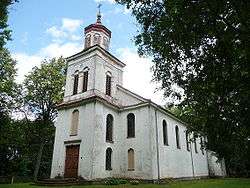
The brick church at Zemoji Panemuné with its stone foundations was built from 1875 to 1877 The church is relatively small with one steeple. The humble, perhaps even rough, appearance of the building can be classified as architecture of the neo-classicist style, although the form of the steeple and the interior have historicist features. The main elements of the interior are the neo-Baroque altars pulpit, and baptismal font, which creates a harmonious ensemble of the historicist style with dominat ing neo-Rococo features.
The late-Baroque brick Church of the Finding of the Holy Cross, located in Kudirkos Naumiestis, attracts with its grandeur. Carmelite monks built the church from 1783 to 1787. The church is of rectangular form, with three arch-spanned naves. The ensemble of the church's facilities is monumen- tal, reserved, almost austere, despite its gilded details and roses and its relief decoration. A buffet-cup- board is preserved in the sacristy, and it is the most artful piece of classicist furniture in the diocese of Vilkaviškis. There are other pieces of furniture in the church which are reminiscent of the Carmelites. A noteworthy collection of furniture made by craftsmen has been assembled in the church. It is almost a small museum of the works created by the carpenters and craftsmen of the area because various installations and pieces of furniture were manufactured at different times. They are not of a uniform style. The majority are made of oak, with simple forms, quite bulky, tastefully decorated in modera tion, and in harmony with the architecture of the building.
The churches and ensembles discussed here in greater detail are listed in the Register of Immov able Cultural Heritage Properties, and several of them are protected by the state, but we can find items of interest in other churches as well. The churches of Plokščiai, Gelgaudiškis, Sintautai, Lukšiai and Slavikai are noteworthy for their bells, while the chapels of Stalioriai and Plieniškiai are notewor thy for their works of art. One can find several valuable works in the churches at Paluobiai, Lekečiai Paežerėliai, and Lukšiai.
In discussing the religious heritage, information was used from the book "Lietuvos sakraliné dailé; book VI, parts I and II, which was compiled by R. Stankevičienė, G. Surdokaitè, and Dr. D. Vasiliunienė.
In the database of Lithuanian manors, 12 estates are listed as located in the territory of the Šakiai district municipality. The complex of buildings of the Church of the Finding of the Holy Cross and the manors of Zypliai, Gelgaudiškis, and liguva are protected by the state, and are among the most signifi- cant and best-preserved. Of them, the best-preserved is the liguva manor. Also worthy of mention are the homesteads of the manors of Kiduliai and Kaimelis. Of the rest of the 12 manors, only fragments remain.
Manors
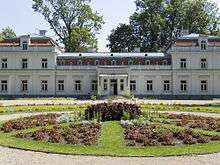
Zypliai manor
The Zypliai manor is one of the newest manors in Lithuania. Its history began less than 200 years ago. The history of the present-day manor begins with the small manor of Old Zypliai, which belonged to the Grand Duke of Lithuania. In 1807,ownership of the manor was transferred to the Duke Juozapas Poniatovskis, who received it for his achievements during the Napoleonic war. In 1813, upon the death of J. Poniatovskis, ownership of the manor was transferred to his sister, Terese Tiškevičiené, who lived in Paris and almost never visited Zypliai. T. Tiškevičienė soon sold Zypliai toJ. Bartkovskis, a landowner of the Plock gubernia. The new owner established a manor near Lukšiai and named it Naujej Zypliai, From 1845 to 1855, a one-storey, modest, brick classicist manor house was built here, as well as two offices, farm buildings, and a parish school. From 1855, the manor was owned by his step daughter Joana Volfers-Kučinskienè. Later, the Zypliai manor was owned by her daughter, Liudvika Ostrovskiené. She sold Zypliai to Count Tomas Potockis (1860-1912), and due to his eforts, from 1898 to 1901 the manor was reconstructed and became more ornate, taking on original neo-Baroque forms. Beginning in 1919, with the Polish taking of Seinai, a seminary for the education of priests was established here. From 1924 to 1944, the Zypliai manor was used as an agricultural school. In 1944, with the retreat of the Germans, a military hospital was established at the manor. During the Soviet period, the office of a collective farm was established at the manor. After the office was moved to Lukšiai, the manor was almost unused and its condition deteriorated. 11 buildings have survived to the present day. In 2002, at the initiative of the Lukšiai elder (local administrator) Vidas Cikana, work was begun to repair and restore the manor, homestead of the manor is composed of two main sectors: a formal area (the manor building and two offices), and a farm-workshop area (kitchen, dairy barn, horse barn, a carriage house, a crafts work granaries, and a kennel). Simultaneously, cultural activity has been renewed at the manor.
"When in 1981 I first saw the neglected Zypliai manor, especially the condition of its main building a flame of hope sprang up within m completely different values. The wonderful park with its ponds,alleys, and little islands sighed under e and was never extinguished, that one day it would live again with the weight of neglect and abandonment. The value of such a large architectural ensemble to the Zanavykai area is immense. Every day, I try to prove my belief in the importance of preserving this ensemble and bringing it back to life. I have devoted the past 10 years of my life to this manor, to make it come back to life and to be a safe place, so that it would become attractive to visitors. I am so pleased that now an active, multi-faceted cultural life has taken root in it, and that the manor is being restored" (Vidas Cikana the head of the Lukšiai eldership).
At present, the Zypliai manor is the most-visited object of cultural heritage in the area. In the former horse barn and in one of the granaries, the rich gallery of the Zypliai manor has been established, while a smithy and a ceramic workshop have been established in the farm-workshop buildings The repaired horse barn has been adapted for intensive cultural activity.
The manor park, occupying a territory of 21 hectares, is one of the largest in Lithuania. The Zypliai manor park is of an irregular geometric layout, and was established in the middle At present, 29 species of foreign and exotic plants have matured here. The pride of the park was the Zypliai oak tree, a natural monument. It was about 360 years old (the circumference of the trunk 630 centimeters, the height of the tree- 34 meters) when the weight of the years finally brought it down.
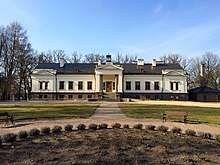
Gelgaudiškis manor
Gelgaudiškis manor is one of the most beautiful and original of the manor ensembles in Lithua having grown into and become a part of the natural environment of the left bank of the Nemun River. The manor house is a one-storey, neo-classicist building, the facades of which are lined with columns, elegant balustrades, beautiful metalwork and other decorative elements. t was at the in tive of Gustavas Koidelis from 1842 to 1846. In the middle of the 19th century, the Koidelis family Gelgaudiškis and departed for Dresden, because in 1887 the government of Russia forbade forei ers living on the borders of the state from owning manors. At the beginning of the 20th century, the manor was purchased by Medardas Komaras. The building was Baroque. The reconstruction the building its neo-classicist style was performed by M. Komaras. The manor house interior also could have been created during the time that Komaras owned the manor (after 1898). The manor contained a park of 300 margas (about 213 hectares), the family chapel, and a cemetery In the 20th century, the deteriorating Gelgaudiškis manor, worn down by the German occupation during the First World War was sold by Komaras to the Lithuanian Women's Society, which established a shelter for about 80 chil dren that was administered by the Sisters of Charity of St. Vincent de Paul. The shelter remained open until 1942. During the Second World War, a military headquarters occupied the manor, and later, amilitary hospital. In 1946, the Gelgaudiškis orphanage was established at the manor. Orphans lived and learned there until 1979, when the building was devastated by a fire. From that time. the manor house a recognised architectural monument, was boarded up, In 2009, restoration work began.
The manor is surrounded by an old park (118.5 hectares). This is one of the largest parks in Lithua- nia, distinguished by a complicated structure consisting of sharp geomet the natural forest of the sl opes leading to the Nemunas River. The main axis of the park is a four-row lley of silver maples that intersect the manor house facing the Nemunas from the south. There is an area in the park called "Żvaigżde" (in English, star). From that open area, clearings have been cut in th f eight countries. A legend claims that the owners of the manor, after hard hours of hunt e open area and, wanting to see the animals, ordered the clearing of paths. At the turn of the 20th century, the park was reconstructed, its landscape was opened up and enriched with Taken as a whole, the Gelgaudiskis park is the most valuable park in the Suvalkija region (Sudovia). In 2000, a path for visitors was established in the park. As one walks the path, one will find the "Velnias" (in English, Devil) hill, the graves of the Koidelis barons, a judge's grave, and one can re- ing, took lunch in th fresh oneself in a constantly gurgling spring...
llguva manor
The llguva manor is located at the confluence of the Nyka and the Nemunas. In 1758, the manor s purchased by Viktoras Grincevičius-llgauskas, the pastor of Veliuona. His family owned the manor until the middle of the 20th century, when Ona Grincevičiûté married Emil Młynarski (1870-1935), the famous Polish composer and violinist, director of the Warsaw Philharmonic. llguva then became a favourite meeting place for musicians.
The wooden manor house was built at the end of the 18th century by Jonas Grincevičius, an offici of the court of King Stanislovas Augustas. The building, facing the Nemunas, stands on a high 80-me- ter precipice. The famous Lithuanian singer Beatriče Grincevičiûtè spent her childhood at the manor Frequent guests at the manor included the priest justinas Pranaitis (a professor at the St. Petersburg spiritual academy), the artists Ferdinandas Ruščicas and Elvyro Andriolli, the famous violinist Paweł Kochański, the composer Karol Szymanowski, and the pianist and songmaker, later the Prime Minister of Poland, Ignacy Paderewski. During the interwar years, guests at the manor included the famous pianist Arthur Rubinstein, the writer and professor Albinas Herbačiauskas, the artist Kazys Simelionis the historian and professor Jonas Totoraitis, and the composer Stasys Simkus. A frequent guest and for a certain period of time a resident at the manor was the writer and priest Antanas Tataré.
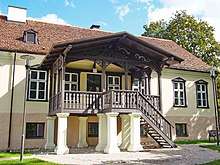
Kiduliai manor
One is reminded of Kiduliai's past by the century-old park and the manor ensemble dating from the 19th century, which is now an architectural monument of local importance. It is written in histori- cal sources that Wilhelm II, the King of Prussia, lived in the manor until 1807, when the Peace of Tilsi was signed. At present, the manor ensemble awaits restoration. The curious passer-by may take interest in the red-brick wall of the old warehouse.
Famous people
In the district, one can find many objects of cultural heritage connected with Lithuanian statehood, and the cultural and educational activities of famous people and their lives. The birthplaces several signers of the February 16 Act of Independence (J.Vailokaitis, J.Staugaitis, S. Banaitis) are state protected sites. Important objects of heritage include the birthplaces of writers V. and S. Tamulaitis, the priest A. Tataré, the priest and the founder of the Salesian mission in Lithuania A. Skeltys, and the choreographer J. Lingys, as well as the homesteads of the poet Pr. Vaičaitis and of Jablonskis, the noted linguist who is rightfully regarded as the father of the Lithuanian language.
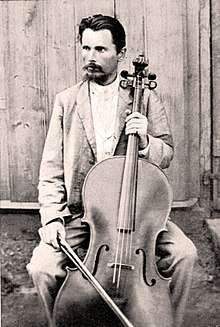
The grave of Vincas Kudirka (writer, editor of the "Varpas" newspaper, and author of the Lithuanian national anthem) in the cemetery of Kudirkos Naumiestis and the monument created by V. Grybas in memory of V. Kudirka in the city square are both state-protected. There are a considerable number of monuments bearing witness to the historical events and personalities of the part, they are crosses, roofed-shrine poles, and chapels. It is worth mentioning the monument to the volunteers in Plokščiai, who in 1918-1921 gave up their lives for Lithuanian inde the monument to Vytautas the Great in Kudirk region. For the most os Naumiestis, the monuments to mark the 10th anniversary of Lithuanian independence in Lekėčiai and the village of Sutkai, the decorative sculptures Sederevičius in Kudirkos Naumiestis, the two-storey roofed-shrine pole in the churchyard of the Lukšiai church, a cross made by P. Tamašauskas in the town of Barzdai, and others.
Burial grounds, closed cemeteries, and the graves of soldiers and prominent citizens remind us of the wars that have stormed across the land, the famous people of the region, and certain periods of our history. The graves of V. Kudirka (the author of the Lithuanian national anthem), Pr. Vaičaitis (a poet), M. Sederevičius (a smuggler of books at a time when writings in the Lithuanian language were prohibited), and E. Steponaitis (a young writer) are frequently visited.
Old village cemeteries and other burial places await, and receive, the care and attention of village communities.
Gallery
- Town hall of Šakiai
- Church of John the Baptist
- Šakiai Evangelical Lutheran Church
- Bust of Vincas Kudirka in Šakiai
International relations
Twin towns — Sister cities
Šakiai is twinned with:
References
| Wikimedia Commons has media related to Šakiai. |

